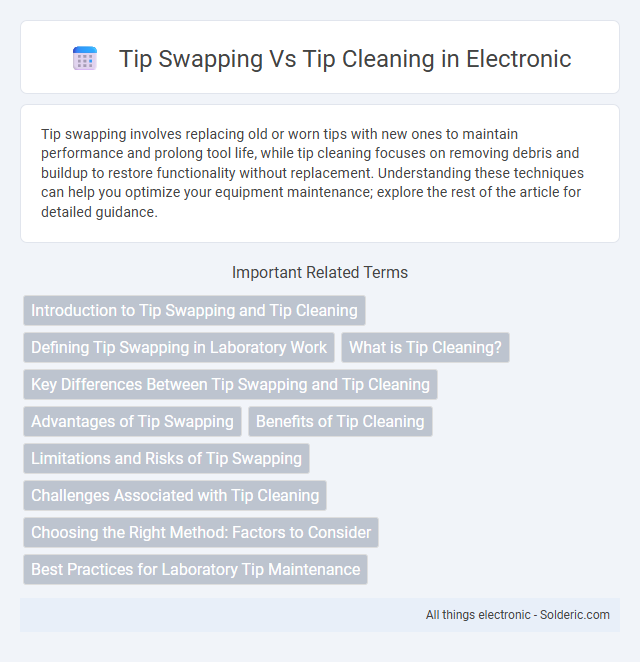Tip swapping involves replacing old or worn tips with new ones to maintain performance and prolong tool life, while tip cleaning focuses on removing debris and buildup to restore functionality without replacement. Understanding these techniques can help you optimize your equipment maintenance; explore the rest of the article for detailed guidance.
Comparison Table
| Feature | Tip Swapping | Tip Cleaning |
|---|---|---|
| Definition | Replacing the used pipette tip with a new one | Removing contaminants from the same pipette tip for reuse |
| Purpose | Prevent cross-contamination by using a fresh tip | Reduce tip usage and waste by cleaning tips between uses |
| Contamination Risk | Minimal to none | Possible if cleaning is incomplete |
| Cost | Higher due to frequent tip consumption | Lower by reusing tips after cleaning |
| Time Efficiency | Faster as no cleaning required | Slower due to cleaning steps |
| Environmental Impact | Higher plastic waste | Reduced plastic waste |
| Common Applications | Standard molecular biology, analytical labs | Automated systems with built-in cleaning protocols |
Introduction to Tip Swapping and Tip Cleaning
Tip swapping involves replacing worn or contaminated tips with new ones to maintain optimal precision and hygiene in equipment like soldering irons or 3D printers. Tip cleaning, on the other hand, uses mechanical or chemical methods to remove residue and oxidation from existing tips, extending their lifespan and ensuring efficient performance. Proper implementation of both techniques minimizes downtime and enhances the accuracy of electronic assembly or fabrication processes.
Defining Tip Swapping in Laboratory Work
Tip swapping in laboratory work refers to the process of exchanging pipette tips between samples or reagents to prevent cross-contamination and ensure precise liquid handling. This technique is crucial in high-throughput experiments, where accuracy and sample integrity directly impact the reliability of results. Proper tip swapping protocols minimize the risk of sample carryover, enhancing reproducibility in molecular biology, genomics, and pharmaceutical research.
What is Tip Cleaning?
Tip cleaning involves the process of maintaining soldering iron tips by removing oxidation and residue to ensure optimal heat transfer and soldering performance. Unlike tip swapping, which replaces the entire tip, tip cleaning extends the life of your existing tip through techniques such as using a brass sponge or wet sponge. Regular tip cleaning helps prevent poor solder joints and enhances the reliability of your soldering work.
Key Differences Between Tip Swapping and Tip Cleaning
Tip swapping involves replacing worn or contaminated tips with new ones to ensure optimal performance in applications like soldering, while tip cleaning focuses on removing oxidation and residue from the existing tip to restore functionality. Swapping is a more effective long-term solution for severely damaged tips, whereas cleaning is a maintenance practice that extends the life of the tip during regular use. The choice between tip swapping and tip cleaning depends on the tip's condition, frequency of use, and the precision required in the task.
Advantages of Tip Swapping
Tip swapping offers significant advantages, including reduced downtime and increased productivity by allowing users to quickly exchange worn tips without interrupting workflow. It extends equipment lifespan by minimizing heat exposure and wear on individual tips, promoting consistent performance across tasks. Furthermore, tip swapping enhances precision and safety by maintaining optimal tip condition, reducing the risk of defects or accidents during soldering or welding processes.
Benefits of Tip Cleaning
Tip cleaning enhances soldering iron longevity by preventing oxidation and buildup on the tip, ensuring optimal heat transfer. Maintaining a clean tip reduces the risk of poor solder joints, improving overall joint reliability and electrical performance. Regular tip cleaning also minimizes solder bridging and defects, leading to more efficient and precise soldering processes.
Limitations and Risks of Tip Swapping
Tip swapping in microscopy poses significant limitations, including the risk of cross-contamination between samples and mechanical damage to the probe tips, which can degrade imaging accuracy. Unlike tip cleaning, which preserves tip integrity by removing contaminants through chemical or physical methods, tip swapping introduces variability due to inconsistencies among different tips. This practice can compromise experimental reproducibility and reduce instrument lifespan, emphasizing the importance of careful consideration in high-precision applications.
Challenges Associated with Tip Cleaning
Tip cleaning in scanning probe microscopy often faces challenges such as potential contamination buildup and incomplete removal of debris, which can degrade imaging resolution and reproducibility. The process may inadvertently alter the tip structure, leading to inconsistent tip performance and reduced tip lifespan. These issues necessitate careful control of cleaning parameters and frequent monitoring to maintain optimal tip quality.
Choosing the Right Method: Factors to Consider
Choosing the right method between tip swapping and tip cleaning depends on factors such as the condition of the soldering iron tip, frequency of use, and precision required in specific tasks. Tip swapping is ideal for users needing quick changes or working with various materials, offering efficiency and convenience. Tip cleaning suits routine maintenance, extending the tip's lifespan while maintaining thermal performance and soldering quality.
Best Practices for Laboratory Tip Maintenance
Laboratory tip maintenance involves two primary methods: tip swapping and tip cleaning, each with distinct best practices. Tip swapping requires strict protocols for avoiding cross-contamination by using sterile, disposable tips for each sample or reagent, ensuring accuracy in sensitive assays. Tip cleaning mandates thorough and validated washing procedures with appropriate solvents and decontamination steps to maintain tip integrity and prevent sample carryover in automated liquid handling systems.
tip swapping vs tip cleaning Infographic

 solderic.com
solderic.com